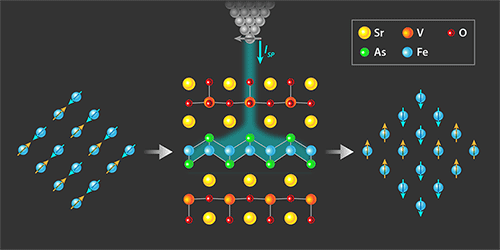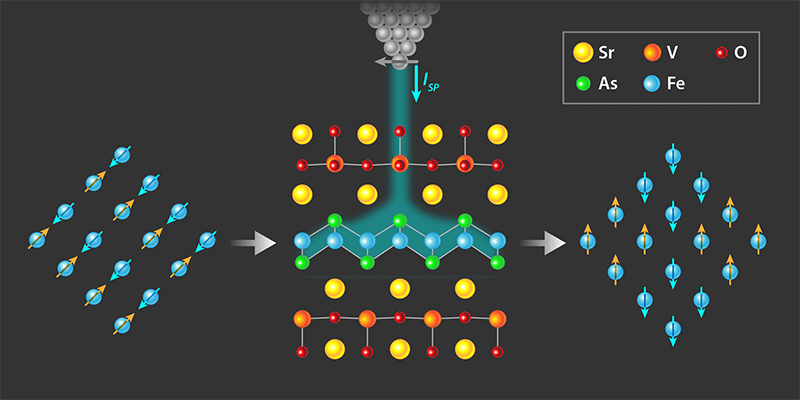Order on Command
In 1996, Luc Berger and John Slonczewski [1] conceived of a way to use an electrical current to reverse the magnetization of a thin metal film. The trick was to apply a current of electrons whose spins were aligned in the same direction: Upon passing through the film, this “spin current” would exert a large enough torque on the film’s magnetization to flip it around. Experimentalists soon demonstrated the predicted switching effect [2], which led, among other things, to racetrack memories—devices that use a spin current to move and position information encoded in tiny magnetic domains [3]. Seokhwan Choi of the Korea Advanced Institute of Science and Technology and co-workers have now uncovered a new type of spin-current switching effect, this time in an iron-based superconductor [4]. The researchers show that the current can be used to modify two phenomena—magnetism and superconductivity—that coexist in the material. The effect could, like the one Berger and Slonczewski predicted, lead to new types of devices and experiments.
Magnetism and superconductivity are often perceived as being antagonistic. The view is reasonable because magnetism usually implies localized magnetic moments, which can rip apart the delicately paired spin-up and spin-down electrons (Cooper pairs) in a superconducting condensate [5]. But magnetism and superconductivity don’t have to be at odds. An extreme example is reentrant superconductivity [6], in which a magnetic material is turned into a superconductor in the presence of a strong magnetic field [7]. The iron-based superconductors that Choi et al. study, known as iron pnictides, provide another case in point. In these materials, superconductivity and magnetism can coexist. Now, whether this is a mere coincidence or a significant fact is a subject of debate. The iron pnictides fall into the high-temperature (high- Tc) class of superconductors because their electrons pair at much higher temperatures than expected by conventional superconductivity theory. And while some explanations for high- Tc superconductivity hold that it arises from a coupling of the electrons to fluctuations in spin polarization that are often associated with magnetism, the idea has yet to be proven experimentally.
The work by Choi et al. is a step towards exploiting the properties of magnetism and superconductivity together. The team works with Sr2VO3FeAs. Like many other pnictides, this compound’s iron (Fe) atoms, which are magnetic, sit in distinct atomic layers (Fig. 1, center). Previous studies have shown that at 5 K, the temperature of Choi and colleagues’ experiments, the spins of the Fe atoms align in a pattern known as C2, so-named for its twofold rotational symmetry (Fig. 1, left). Consistent with this observation, the researchers find that when they scan the surface of Sr2VO3FeAs with the tip of a scanning tunneling microscope (STM), they detect stripe-like features in the arrangement of surface atoms. The twofold rotational symmetry of these features changes to fourfold rotational, however, when the researchers inject into the material a sufficiently large spin current—here produced by outfitting the STM with a magnetic tip. From this, the researchers conclude that the iron spins form a pattern, known as C4, that also has fourfold rotational symmetry (Fig. 1, right). This pattern is antiferromagnetic, meaning half the spins point in one direction, and the other half point the opposite way.
In itself, the finding that a spin current from the STM provides the necessary torque to switch the magnetic order from the C2 to C4 type is new and unexpected. But the researchers learn more by using the STM to measure the electronic landscape of the surface of Sr2VO3FeAs at various temperatures and polarizations of the spin current. For example, with the STM tip at different positions on the surface, they determine the electron density of states, which entails measuring the tunneling current between the surface and the tip as a function of the voltage between them. By comparing the features in this STM electron spectrum with models, Choi et al. determined that the superconducting gap, which is a measure of the strength of Cooper pairing in the superconductor, is smaller in a C4-pattern region than it is in a C2 region. Therefore, this result suggests that C4 magnetism suppresses superconductivity.
Finding such a direct link between superconductivity and magnetism would be exciting news for those hoping to explain high- Tc superconductivity. But it’s worth emphasizing that Choi et al. do not detect antiferromagnetic order or superconductivity directly. Irrevocable evidence for antiferromagnetism would require a measurement of the spin variation with atomic-scale resolution. Similarly, to confirm that the STM electron spectra that Choi et al. obtain are truly sensitive to the superconducting gap, one should ideally probe the gap directly. This could be done with a modified type of STM that has a superconducting tip [8].
Once the natures of the magnetic and superconducting orders are nailed down, the effects observed by Choi et al. could inspire one to dream up all kinds of devices and experiments, not all of them equally realistic. For example, one feasible idea would be to harness the spin current to “write” information on the nanoscale, with the current serving to flip a magnetic region from one type of order to another or to turn superconductivity on or off. Another possibility would be to use the current to produce a small magnetic, but not superconducting, region of the material that weakly couples two superconducting regions. Such a setup could be used to make switchable superconducting electronic devices. On the fundamental physics front, the ability to locally control magnetism and superconductivity with an STM as demonstrated by Choi et al. might allow researchers to study how these seemingly antagonistic phases manage to coexist in iron pnictides. And with any luck, such measurements will tell us to what extent (if at all) magnetism is an essential ingredient in high- Tc superconductivity.
This research is published in Physical Review Letters.
References
- L. Berger, “Emission of Spin Waves by a Magnetic Multilayer Traversed by a Current,” Phys. Rev. B 54, 9353 (1996); J. C. Slonczewski, “Current-Driven Excitation of Magnetic Multilayers,” J. Magn. Magn. Mater. 159, 1 (1996).
- M. Tsoi, A. G. M. Jansen, J. Bass, W.-C. Chiang, M. Seck, V. Tsoi, and P. Wyder, “Excitation of a Magnetic Multilayer by an Electric Current,” Phys. Rev. Lett. 80, 4281 (1998); E. B. Myers, D. C. Ralph, J. A. Katine, R. N. Louie, and R. A. Buhrman, “Current-Induced Switching of Domains in Magnetic Multilayer Devices,” Science 285, 867 (1999); J. A. Katine, F. J. Albert, R. A. Buhrman, E. B. Myers, and D. C. Ralph, “Current-Driven Magnetization Reversal and Spin-Wave Excitations in Co/Cu/Co Pillars,” Phys. Rev. Lett. 84, 3149 (2000).
- L. Thomas, M. Hayashi, X. Jiang, R. Moriya, C. Rettner, and S. Parkin, “Resonant Amplification of Magnetic Domain-Wall Motion by a Train of Current Pulses,” Science 315, 5818 (2007).
- S. Choi et al., “Switching Magnetism and Superconductivity with Spin-Polarized Current in Iron-Based Superconductor,” Phys. Rev. Lett. 119, 227001 (2017).
- A. A. Abrikosov and L. P. Gorkov, “Contribution to the Theory of Superconducting Alloys with Paramagnetic Impurities,” Zh. Eksp. Teor. Fiz. 39, 1781 (1960), [JETP 12, 1243 (1961)].
- V. Jaccarino and M. Peter, “Ultra-High-Field Superconductivity,” Phys. Rev. Lett. 9, 290 (1962).
- H. W. Meul, C. Rossel, M. Decroux, Ø. Fischer, G. Remenyi, and A. Briggs, “Observation of Magnetic-Field-Induced Superconductivity,” Phys. Rev. Lett. 53, 497 (1984); Ø. Fischer, H. W. Meul, M. G. Karkut, G. Remenyi, U. Welp, J. C. Piccoche, and K. Maki, “Antivortex Paramagnetism in the Magnetic-Field-Induced Superconducting State of EuxSn1−xMo6S,” 55, 2972 (1985).
- H. Kimura, R. P. Barber, S. Ono, Y. Ando, and R. C. Dynes, “Josephson Scanning Tunneling Microscopy: A Local and Direct Probe of The Superconducting Order Parameter,” Phys. Rev. B 80, 144506 (2009).





